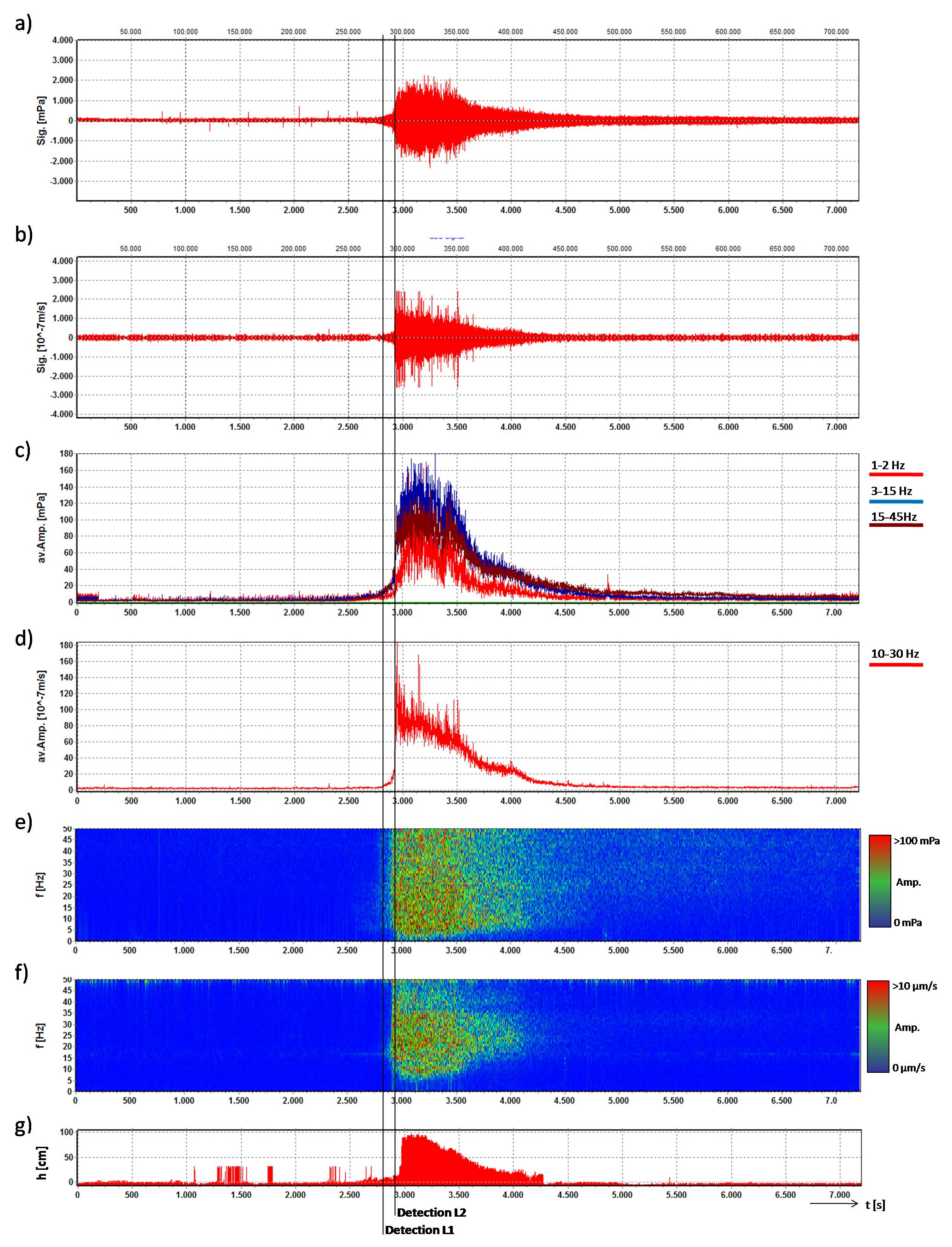Due to the fast socio-economic development of mountain areas, processes like debris flows, debris floods, or bed load transport,
constitute an increasing hazard to lives and property. Monitoring debris flow torrents is essential for warning issues and gaining more
knowledge about the processes. Debris flows and debris floods induce, by the collision of stones and by the friction of the flow to the channel, waves in the
low-frequency infrasonic spectrum and seismic waves. The characteristic frequency range in which the largest amplitudes occur varies
for infrasound signals depending on the viscosity from 5 to 10 Hz for debris flows with high sediment content up to 15-30 Hz for debris floods
with lower viscosity (e.g. Chou et al. 2010, Kogelnig et al. 2014) and from 10 to 30 Hz for seismic signals (e.g. Arattano et al. 2003).
The fact that debris flows have a characteristically pattern in the time-frequency range for the infrasound and seismic signals, permits an early detection
and identification of these events, even before a surge passes the sensor location.
Several approaches to detect debris flows with infrasonic or seismic sensors are already existing (e.g. Zhang et al. 2004; Chou et al. 2010)
but so far no warning system based on a combination of seismic and infrasound sensors has been developed and no approach for identifying
mass movement processes in respect to their process-type, and magnitude based on this both signals has been considered.
By the combination of infrasound and seismic signals advantages can be taken of both technologies and the disadvantages can be minimized
(e.g. seismic: lower disturbances due to wind and weather but strong dependency on the geology of the site and high attenuation with increasing
distance between mass movement and sensor; infrasound: little attenuation in the air at local distances, but high background noise induced by wind).
This concept aims to build up a warning system for detecting and identifying alpine mass movements by analysing the seismic and infrasound waves.
The developed system is build up on a minimum of one seismic and one infrasound sensor which are co-located and a microcontroller which runs a
detection algorithm to detect debris flows and debris floods with high accuracy in real time directly on-site. An overview of the hardware components and the inputs
and outputs of the system is given in Figure 1.

Fig. 1: Overview system setup and components.
The developed detection algorithm analyses the evolution in time of the frequency content from the infrasonic and seismic mass movement signals. Therefore three different frequency bands
are used to analyse the infrasound signal, whereby a 3 to 15 Hz band characterises debris flows and a 15 to 45 Hz band is used for debris floods.
The frequency bands below (manly dominated by wind) is used to eliminate false alarms. The advantage of the combination becomes clear by
looking at the number of detections: e.g. test site Farstrinne 2014: 176 detections based on seismic signals, 6 detections based on infrasound,
2 correct detections with the combination of both signals.
Figure 2 shows an example of the seismic and infrasound signals, amplitudes of the frequency bands and the spectrum of a debris flow occurred at the
Tyrolese test site Lattenbach on 16.08.2015. The time between detection and passing of the main surge for this event was 40 s which is an adequate
time for early warning.

Fig. 2: Infrasound and seismic data of the debris flood monitored at the Lattenbach test site on 16.08.2015. Signals are represented with a common base of time. (a) Infrasound time series; (b) Seismogram; (c) Average amplitude of the four frequency bands of the infrasound signal; (d) Average amplitude of the frequency band of the seismic signal; (e) Running spectrum of the infrasound signal; (f) Running spectrum of the seismic signal; (g) Flow hight Line: time of first detection based on infrasound and seismic data.
The System has been installed at twelve different test sites in Austria, Italy and Switzerland. All 22 debris flow events which occurred in the test periode from 2013 to 2016 has been detected
and also the most of smaller debris floods and bedload transport processes has been identified. During the whole operation time only 7 false alarms were registered.
Further work will compare the data of recorded events with information of other measurement systems at several test sites, to define a common set
of identification rules for event-type and magnitude identification. The detection system will be extended by this identification rules and the
developed process identification system will then be tested on several test sites.
References:
ARATTANO M. (2003): Monitoring the presence of the debris-flow front and its velocity through ground vibrations detectors,
Proceedings of the Third International Conference on Debris-Flow Hazards Mitigation: Mechanics, Prediction and Assessment, Millpress, Rotterdam, Vol.2, pp731-743.
CHOU, H.T., CHANG, Y.L. AND ZHANG, S.X. (2010): Acoustic signals and geophone response of rainfall-induced debris flows. J. of Chinese Institute of Engineers.
KOGELNIG A., HÜBL J., SURIÑACH E., VILAJOSANA I., MCARDELL B.W. (2014): Infrasound produced by debris flow: Propagation and frequency content evolution, Nat. Hazards.
ZHANG, S., HONG, Y., YU, B. (2004): Detecting infrasound emission of debris flow for warning purpose, 10. Congress Interpraevement 2004.